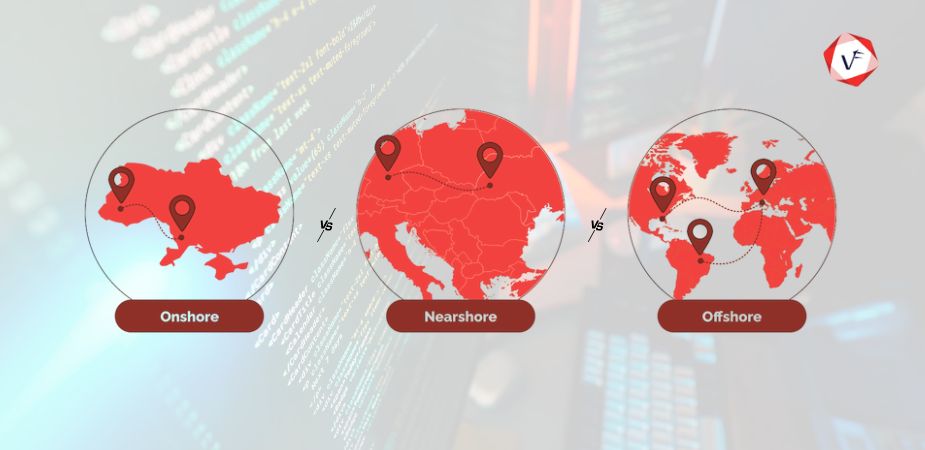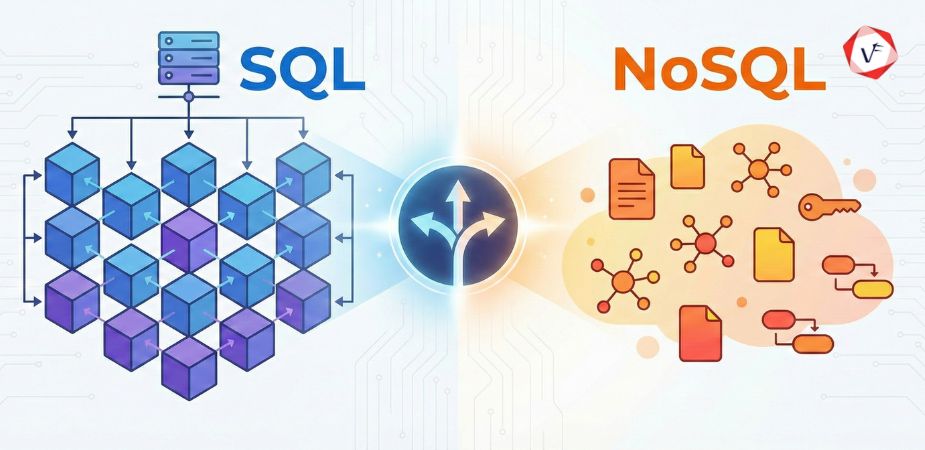- October 03, 2025 5:30 pm
- by Kevin
- October 03, 2025 5:30 pm
- by Sooraj

Updated: October 2025 | Reading Time: 15 min | Topics: Software Outsourcing, Development Teams, Business Strategy
Quick Answer: Nearshore outsourcing offers balanced costs and communication (1-3 hour time difference), offshore provides maximum cost savings (50-70% lower rates), and onshore ensures seamless collaboration with same-country teams. Your choice depends on budget, project complexity, and communication needs.
In an increasingly interconnected business environment, companies face critical decisions about how to structure their operations and leverage external talent. Software development outsourcing has become a strategic approach for organizations seeking to optimize costs, access specialized skills, and accelerate project timelines.
However, choosing between nearshore, offshore, and onshore outsourcing models requires careful consideration of multiple factors that can significantly impact project success. Each outsourcing approach offers distinct advantages and challenges that must align with your specific business objectives, budget constraints, and operational requirements.
Understanding these differences becomes essential for making informed decisions that drive long-term value and sustainable growth for your organization. This comprehensive guide will help you navigate the complexities of outsourcing models and select the best approach for your business needs.
Onshore outsourcing involves partnering with service providers located within the same country as your business. This model maintains geographical proximity while still leveraging external expertise and resources. Companies choosing onshore outsourcing typically work with development teams that share similar time zones, cultural backgrounds, and regulatory environments.
The primary advantage of onshore outsourcing lies in seamless communication and collaboration. When development teams operate within the same time zone, real-time communication becomes effortless, enabling quick decision-making and immediate problem resolution. Cultural alignment also plays a crucial role, as shared business practices and communication styles reduce misunderstandings and streamline project management processes.
However, onshore outsourcing often comes with higher costs compared to other models. Domestic labor rates generally exceed those found in international markets, which can impact project budgets significantly. Additionally, the talent pool may be limited, particularly for specialized technologies or niche skill sets that are in high demand locally.
Key Benefits of Onshore Outsourcing:
Key Challenges: Higher costs (typically 2-3x offshore rates), limited talent pool in specific regions, and potentially higher competition for top developers.
Offshore outsourcing represents the practice of engaging service providers located in distant countries, often across different continents. This model has gained popularity due to substantial cost savings and access to vast talent pools in countries like India, Ukraine, the Philippines, and various Eastern European nations.
Cost efficiency stands as the most compelling reason companies choose offshore outsourcing. Labor costs in many offshore destinations can be 50-70% lower than domestic rates, making this model particularly attractive for budget-conscious organizations. The talent pool available through offshore outsourcing is extensive, with many countries investing heavily in technology education and producing skilled software developers, engineers, and IT professionals.
Offshore outsourcing also enables round-the-clock development cycles. When managed effectively, time zone differences can become an asset, allowing continuous progress on projects as teams in different regions work in sequence. This can accelerate project timelines and improve time-to-market for software products.
Nevertheless, offshore outsourcing presents certain challenges. Communication barriers can arise from language differences, cultural nuances, and varying business practices. Time zone differences, while potentially beneficial, can also complicate real-time collaboration and quick decision-making processes. Additionally, managing remote teams across vast distances requires sophisticated project management approaches and tools.
Key Benefits of Offshore Outsourcing:
Key Challenges: Time zone differences (8-12 hours), potential language barriers, cultural differences affecting work styles, and increased management complexity.
Nearshore outsourcing involves partnering with service providers in nearby countries, typically within the same region or continent. For North American companies, this might mean working with teams in Mexico, Costa Rica, or Argentina. European businesses might consider nearshore partners in Eastern Europe or neighboring countries.
This model attempts to balance the cost advantages of offshore outsourcing with the communication benefits of onshore partnerships. Nearshore locations often offer labor costs that are lower than domestic rates while maintaining closer geographical proximity and cultural similarity than offshore alternatives.
Time zone alignment represents a significant advantage of nearshore outsourcing. Teams working within one to three hours of each other can maintain overlapping business hours, facilitating real-time communication and collaboration. Cultural proximity also tends to be greater than with offshore partnerships, reducing potential misunderstandings and improving working relationships.
Nearshore outsourcing typically provides access to well-educated, technically skilled professionals who may have experience working with companies from your region. Many nearshore locations have developed strong technology sectors specifically to serve their neighboring markets, resulting in professionals who understand regional business practices and customer expectations.
Key Benefits of Nearshore Outsourcing:
Key Challenges: Costs higher than offshore options, potentially smaller talent pools than major offshore destinations, and varying levels of technical expertise by country.
Budget constraints often serve as the primary deciding factor in outsourcing decisions. Offshore outsourcing typically offers the greatest cost savings, with development rates that can be significantly lower than domestic alternatives. However, these savings must be weighed against potential hidden costs such as increased management overhead, communication tools, and quality assurance measures.
Nearshore outsourcing provides a middle ground, offering cost savings compared to onshore options while potentially requiring less management overhead than offshore partnerships. The cost differential may be less dramatic than offshore alternatives, but the improved communication and collaboration can result in faster project completion and fewer costly revisions.
Onshore outsourcing, while more expensive, may provide better value for complex projects requiring extensive collaboration, frequent changes, or tight integration with existing systems. The reduced communication overhead and cultural alignment can lead to more efficient development processes and higher-quality deliverables.
Cost Comparison Overview:
The complexity of your project significantly influences the most suitable outsourcing model. Simple, well-defined projects with clear requirements may be excellent candidates for offshore outsourcing, where cost savings can be maximized without sacrificing quality. These projects typically require minimal ongoing communication and can be managed effectively despite time zone differences.
Complex projects requiring frequent collaboration, iterative development, or close integration with existing systems may benefit from nearshore or onshore outsourcing. The ability to maintain regular communication and quickly address issues as they arise becomes crucial for project success.
Projects involving sensitive data, regulatory compliance, or intellectual property concerns may also favor onshore or nearshore options, where legal frameworks and data protection regulations are more familiar and potentially more aligned with your business requirements.
Project Type Recommendations:
Communication requirements vary significantly across different types of projects and organizational cultures. Some companies thrive with asynchronous communication patterns and detailed documentation, making offshore outsourcing highly effective. Others require frequent face-to-face meetings, real-time collaboration, and immediate feedback loops that favor onshore or nearshore partnerships.
Cultural alignment affects not only communication but also work styles, problem-solving approaches, and business practices. Companies that prioritize cultural fit and seamless integration with their existing teams may find onshore outsourcing more suitable, despite higher costs.
Language proficiency also plays a critical role in communication effectiveness. While many offshore destinations offer English-speaking developers, accent differences and language nuances can still impact communication clarity. Nearshore locations often provide better language alignment for North American and European companies.
Communication Best Practices by Model:
Time zone differences can be both an asset and a challenge depending on your specific needs. Companies requiring 24/7 development cycles or follow-the-sun development models may benefit from offshore partnerships that enable continuous progress across different time zones.
However, businesses that need immediate responses, frequent meetings, or real-time collaboration may struggle with significant time zone differences. Nearshore outsourcing offers the best of both scenarios, providing some time zone overlap while still offering cost advantages.
Consider your team's working hours and meeting requirements. If daily standups, sprint planning, and regular check-ins are essential to your workflow, nearshore or onshore options provide better synchronous communication opportunities.
Time Zone Impact Analysis:
Selecting the appropriate outsourcing model requires careful analysis of your specific business context, project requirements, and organizational capabilities. Consider conducting a thorough assessment of your communication needs, budget constraints, project complexity, and risk tolerance.
Many successful companies employ a hybrid approach, using different outsourcing models for different types of projects or development phases. For example, you might use offshore teams for initial development and testing, then transition to nearshore or onshore resources for integration and deployment phases.
The decision should also consider your organization's experience with outsourcing. Companies new to outsourcing might benefit from starting with nearshore or onshore partnerships to develop their remote management capabilities before exploring offshore options.
Decision Framework:
Key Takeaway: Most successful organizations use a hybrid approach, selecting the outsourcing model based on individual project requirements rather than committing to a single strategy across all initiatives.
Quality assurance requirements differ significantly across outsourcing models, requiring tailored approaches for each strategy. Offshore outsourcing often demands more rigorous quality control measures due to potential communication gaps and cultural differences that can affect deliverable standards.
Establishing comprehensive testing protocols, detailed documentation requirements, and regular quality checkpoints becomes essential for maintaining project standards when working with distant teams. Automated testing frameworks and continuous integration pipelines become particularly valuable for offshore partnerships.
Onshore outsourcing typically allows for more integrated quality assurance processes, where external teams can participate directly in your existing quality control frameworks. This integration reduces the need for separate quality management systems while maintaining visibility into development processes.
However, the assumption that geographical proximity automatically ensures quality can be misleading without proper oversight mechanisms. Regardless of the outsourcing model, implementing clear quality standards, regular code reviews, and performance metrics remains essential.
Nearshore outsourcing enables a balanced approach to quality management, combining the benefits of closer oversight with cost-effective quality assurance processes. Teams operating in similar time zones can participate in regular quality reviews and implement feedback more quickly than offshore alternatives while maintaining structured quality control measures.
Quality Management Best Practices:
Data security and regulatory compliance requirements significantly influence outsourcing decisions, particularly for companies handling sensitive information or operating in regulated industries. Offshore outsourcing may present additional security challenges due to varying data protection regulations, international data transfer requirements, and potential differences in security standards between countries.
Onshore outsourcing typically provides the highest level of compliance alignment, as domestic service providers operate under the same regulatory frameworks and legal requirements as your organization. This alignment simplifies compliance management and reduces legal risks associated with data handling and intellectual property protection.
Industries subject to strict regulations such as HIPAA (healthcare), GDPR (data privacy), PCI-DSS (financial services), and SOC 2 compliance often prefer onshore or nearshore partners who understand and operate under these frameworks. The cost of non-compliance can far exceed any savings achieved through offshore outsourcing.
Nearshore outsourcing offers a middle ground for security and compliance, particularly when partnering with countries that have established data protection agreements or similar regulatory standards. Many nearshore locations have developed robust cybersecurity frameworks specifically to attract international business partnerships.
Security Considerations by Model:
Key Security Best Practices:
Choosing between nearshore, offshore, and onshore outsourcing requires balancing cost considerations, communication needs, project complexity, and organizational capabilities. Each model offers distinct advantages that can drive business success when properly aligned with your specific requirements.
Whether you prioritize cost savings, communication efficiency, or cultural alignment, understanding these differences enables informed decision-making that supports your business objectives. The key is to match the outsourcing model to your project's specific needs rather than adopting a one-size-fits-all approach.
Quick Decision Guide:
For organizations seeking reliable software outsourcing services that deliver exceptional value, Vofox's comprehensive outsourcing solutions provide the expertise and flexibility needed to achieve your development goals successfully. Our team can help you navigate these decisions and implement the right outsourcing strategy for your business.
Ready to get started? Contact our experts to book your appointment today and discover how the right outsourcing model can accelerate your software development initiatives while optimizing costs and maintaining quality standards.
Summary: The most successful outsourcing strategies often combine multiple models, leveraging offshore teams for cost-effective development, nearshore partners for balanced collaboration, and onshore resources for critical integrations—all while maintaining rigorous quality standards and security protocols.
About Vofox Solutions: We provide comprehensive software outsourcing solutions tailored to your business needs, with expertise across nearshore, offshore, and onshore development models.
Contact Us: Schedule a consultation with our outsourcing experts to find the perfect solution for your project.
Guaranteed Response within One Business Day!

Database Selection Guide: SQL vs NoSQL
AI Agents in Enterprise Software: How Autonomous AI is Transforming Business Operations
Manufacturing 4.0: AI and IoT Transforming Production Lines

Progressive Web Apps vs Native Apps: Which Should You Choose in 2026?

What is Citizen Development?